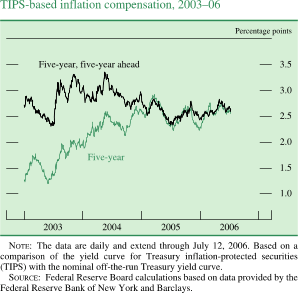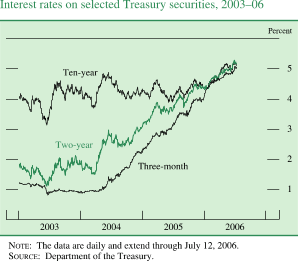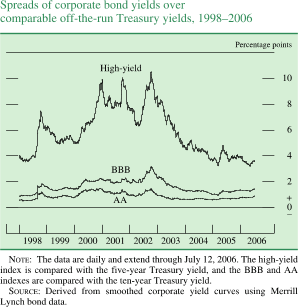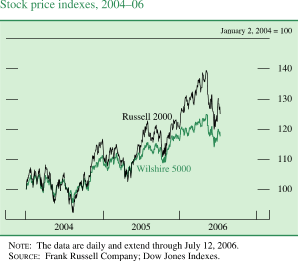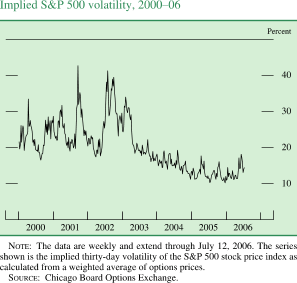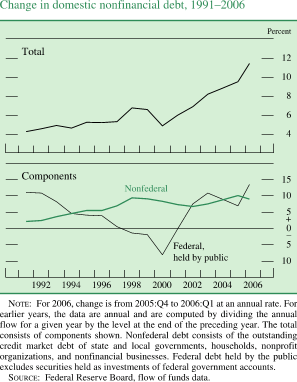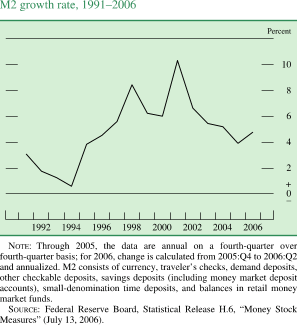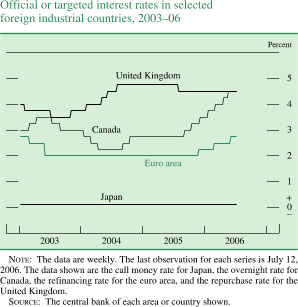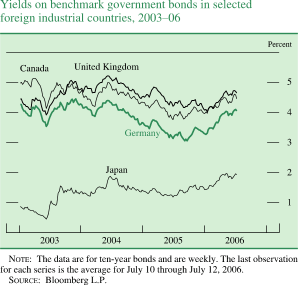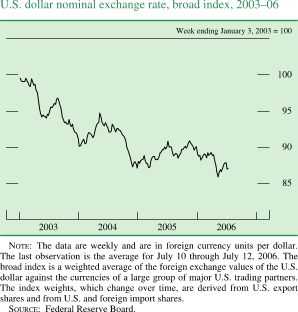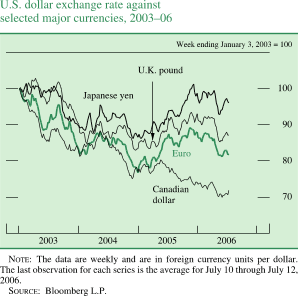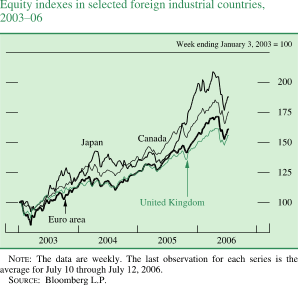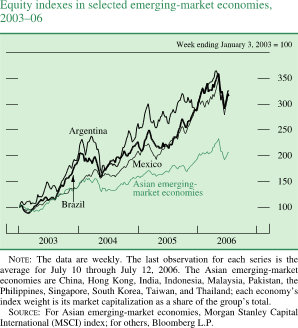
Monetary Policy Report submitted to the Congress on July 19, 2006, pursuant to section 2B of the Federal Reserve Act
Section 2
ECONOMIC AND FINANCIAL DEVELOPMENTS IN 2006
Although last year's hurricanes caused the pace of aggregate economic activity around the turn of the year to be uneven, real GDP increased at an average annual rate of 3.6 percent in the final quarter of 2005 and first quarter of 2006--about the same pace that prevailed during the preceding year and a half. Over this period, payroll employment posted additional solid gains, and the unemployment rate declined further. In recent months, the incoming information on real activity has suggested that the pace of the expansion is moderating, with the deceleration in spending most apparent in the household sector. Still, as of midyear, resource utilization in labor and in product markets remained high.
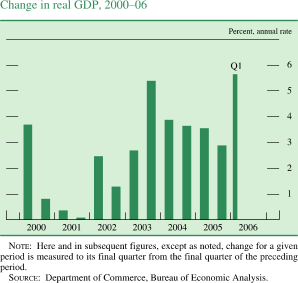
Inflation picked up over the first five months of the year, boosted importantly by the effects of rising energy prices. Long-term inflation expectations fluctuated over the period but remained contained, and increases in unit labor costs were subdued. Although short-term market interest rates rose in line with the FOMC's firming of monetary policy, financial market conditions were still generally supportive of economic expansion in the first half of 2006. Long-term interest rates rose but were still moderate by historical standards, and credit spreads and risk premiums stayed narrow.
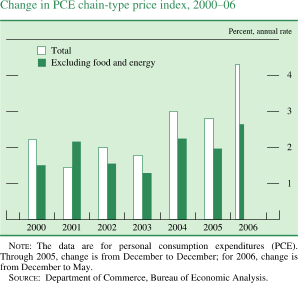
The Household Sector
Consumer Spending
After increasing at a robust rate around the turn of the year, consumer spending has been rising at a more moderate pace in recent months. Over the first half of 2006, rising employment and the lagged effect of increases in wealth continued to provide support for spending by households. However, consumers' purchasing power was restrained by a further run-up in energy costs in the spring.
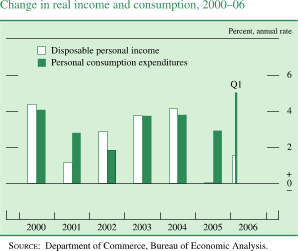
Sales of new cars and light trucks bounced back sharply at the turn of the year; those sales had slackened in late 2005 after manufacturers ended the special "employee discount" programs that had boosted sales last summer. New light vehicles sold at an annual rate of 16.8 million units between January and April, about the same as the average rate in 2004 and 2005. However, elevated gasoline prices affected the composition of demand, and consumers shifted their purchases away from light trucks and sport-utility vehicles (SUVs) and toward autos. That shift led to an increase in the market share captured by foreign producers. As households' concerns about the higher price of gasoline weighed on their attitudes toward buying vehicles, sales dipped to an annual rate of 16.2 million units in May and June.
Spending for other household goods, such as furniture, electronic equipment, food, and clothing, was quite strong in the first quarter of 2006; real outlays for goods other than motor vehicles increased at an annual rate of 8-3/4 percent. Some moderation was to be expected after such a surge in spending. Estimates of retail sales, which are available through June, suggest that real expenditures for these goods rose more slowly in the second quarter. In contrast to the uneven pattern of spending for goods, real outlays for consumer services remained on a moderate upward trend over the first half of 2006; they rose at an annual rate of 2-1/2 percent from the fourth quarter of 2005 through May 2006.
Boosted by gains in nominal wage and salary income, after-tax aggregate personal income rose at an annual rate of 4 percent over the first five months of 2006. However, the acceleration in consumer prices held real income about constant. As a result, the steep decline in the personal saving rate, which began in 2004, extended into 2006. Since 2003, rising household wealth has provided important support for spending, even as gains in real income have been damped by increases in energy prices. In 2005 and the first part of 2006, much of the increase in wealth was the result of the rapid appreciation in the value of homes.
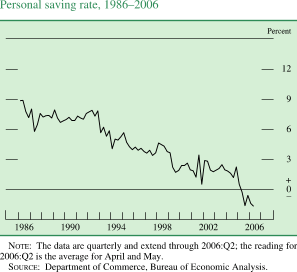
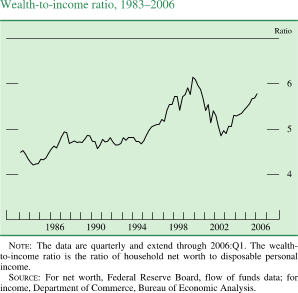
According to the survey by the University of Michigan Survey Research Center (SRC), the run-up in energy prices contributed importantly to the deterioration in consumer confidence this spring. Consumers' pessimism peaked in May and then lessened somewhat, on average, in June and early July. Nonetheless, at midyear, households indicated that they were still concerned about the effect of the high cost of energy on their financial situation. In addition, households' assessments of current and expected business conditions remained considerably less optimistic than they were at the beginning of the year.
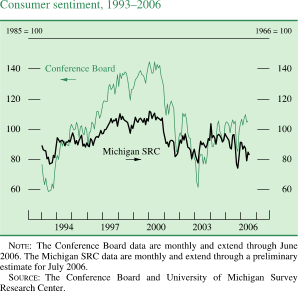
Residential Investment
The demand for homes had begun to soften in the summer of 2005, and, by the spring of 2006, starts of new single-family homes were well below the very rapid pace that had prevailed in the preceding two years. The reduced level of activity in real estate markets also led to some easing in house-price appreciation early this year.
Sales of new and existing single-family homes, which had been climbing steadily since 2003, stopped rising during the third quarter of 2005. By May, sales of new and existing homes together were 7-1/4 percent below their peak in June 2005. The cooling in sales caused inventories of unsold homes to rise. In May, the backlog of unsold new homes equaled 5-1/2 months' supply at that month's selling rate, and the backlog of existing homes on the market was 6-1/2 months' supply; in 2005, the stocks of both unsold new and existing homes averaged roughly 4-1/2 months of supply.
An increase in mortgage rates contributed to the slackening in the demand for housing. Since the middle of 2005, the average rate for a thirty-year fixed-rate mortgage has increased about 1 percentage point, to 6-3/4 percent, and the average for a one-year adjustable-rate mortgage has risen a bit more, to 5-3/4 percent. According to respondents to the Michigan SRC survey, the rise in borrowing costs has been an important consideration damping their assessment of buying conditions for homes since mid-2005; the rise in home prices has apparently also weighed on consumers' attitudes.
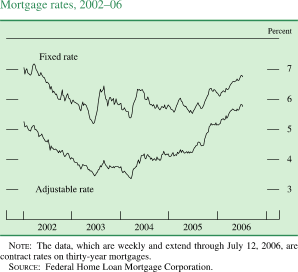
Although recent increases in house prices have been smaller than those that accompanied the robust real estate markets of 2004 and 2005, the deceleration thus far appears to have been modest. The repeat-transactions index of house prices, which is published by the Office of Federal Housing Enterprise Oversight, increased at an annual rate of 7-1/4 percent in the first quarter of 2006, the smallest quarterly increase since the fourth quarter of 2001; that index attempts to control for the quality of existing single-family homes sold by using prices of homes involved in repeat transactions (excluding refinancings). The first-quarter reading brought the year-over-year change in this measure to 10 percent; in the second and third quarters of 2005, purchase prices according to this index were up 11-1/2 percent from the level of a year earlier. An alternative measure of house prices is the average price of existing single-family homes sold, which is published by the National Association of Realtors. This measure, which does not control for the type of homes sold, showed that the year-over-year change in prices peaked at 11-1/2 percent in August 2005 and then fell to 4 percent in April and May of this year. The greater deceleration in the latter measure suggests that, in addition to some softening in prices, the mix of existing units sold may have shifted toward lower-priced homes.
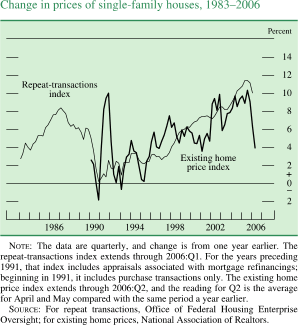
The effect of the slowdown in demand on new construction became apparent during the second half of 2005, when the number of permits issued for new single-family homes began to fall. This year, the decline in permit issuance was relatively steady from January to May. Nonetheless, new single-family homes were started at an exceptionally high annual rate of 1.75 million units during the first quarter, when builders were able to begin work on scheduled projects earlier than normal because of favorable weather conditions. With some starts having been advanced into the first quarter, single-family starts dropped to an average rate of 1.57 million units in April and May. In contrast to the recent trend in the single-family sector, construction of new multifamily homes averaged an annual rate of 360,000 units from January to May, about where it has been for more than four years.
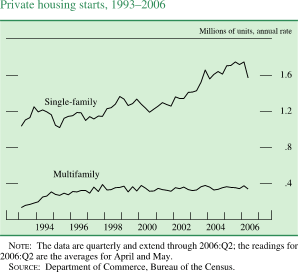
Housing activity, as measured by real expenditures on residential structures, contributed almost -1/2 percentage point per year to the annual rate of increase in real GDP in 2004 and 2005. In the first quarter of 2006, that contribution dropped to 0.2 percentage point; with the reduced pace of sales and construction since the winter, a decline in residential investment is likely to have held down the rise in real GDP in the second quarter.
Household Finance
Household debt expanded at an annual rate of about 11-1/2 percent in the first quarter of 2006, about the same pace as in 2005. Despite the rise in mortgage rates and the slowing in housing activity, home mortgage debt expanded rapidly again early in the year as homeowners apparently continued to extract some of the substantial gains in equity that they have accumulated on their homes in the past several years. Indeed, according to industry estimates, although the number of homeowners refinancing their mortgages has remained well below that seen during the refinancing boom of several years ago, a large fraction of homeowners who have refinanced so far this year have chosen to withdraw equity from their homes. As has been the case in recent years, this mortgage-related borrowing likely replaced, in part, some consumer credit borrowing, which, at an annual rate of a bit less than 3 percent, continued to expand modestly in the first five months of 2006.
The ratio of household financial obligations to disposable income rose 0.1 percentage point in the first quarter to about 18-3/4 percent, narrowly exceeding the top of its historical range. Nonetheless, the evidence points to only limited pockets of financial distress in the household sector. Delinquency rates on residential mortgages were low by historical standards in the first quarter, though they have edged higher since the middle of last year, particularly in the subprime sector. Delinquency rates on consumer debt also continued to be low. Meanwhile, household bankruptcy filings remained subdued in the first half of 2006, running at a pace well below the average of recent years. Bankruptcies have likely been damped this year in part by the decision of some households in the fall of 2005 to accelerate their filings to avoid the implementation of a stricter bankruptcy law in October. More recently, they may also have been restrained by the greater costs of bankruptcy under the new law.

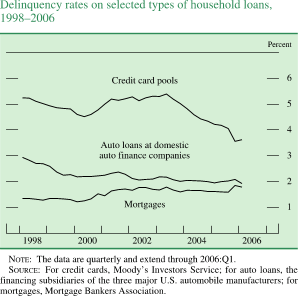
The Business Sector
Fixed Investment
Real business fixed investment increased at a solid rate, on average, during the final quarter of 2005 and the first quarter of 2006. Over that period, real business spending for new equipment and software rose at an annual rate of 9-3/4 percent, a pace similar to that over the first three quarters of 2005. In addition, investment in nonresidential structures, which had remained weak in 2005, turned up noticeably in early 2006. The underlying determinants of capital spending have stayed quite positive: Businesses have seen steady increases in sales, robust profits, and declining user costs for equipment; they have ample liquid assets; and, despite the rise in interest rates, credit quality is strong.
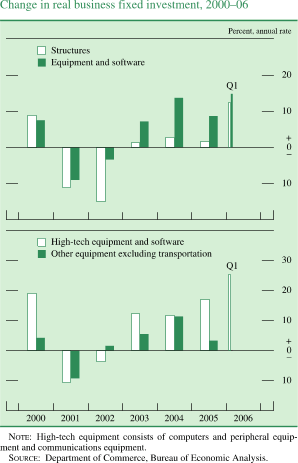
Real outlays for equipment and software rose at an annual rate of 14-3/4 percent in the first quarter after having risen at a 5 percent rate in the fourth quarter of 2005. As can often be the case, the timing of spending for a number of types of equipment was uneven between these two quarters. Business purchases of cars and trucks slowed in late 2005, after manufacturers reduced their special discounts on light vehicles, and then recovered in the first quarter. The first- quarter rebound was strengthened by a further acceleration of outlays for medium and heavy trucks. According to industry analysts, businesses have been pulling forward these purchases because the engines in the 2007 models will be required to meet new emission regulations by the Environmental Protection Agency that will make the new vehicles more costly to operate. Deliveries of commercial aircraft to domestic customers also rebounded in the first quarter from a very low level in the fourth quarter.
Demand for high-technology equipment stepped up noticeably in the first quarter because of a sharp jump in outlays for communications equipment. Providers of telecommunications services appear to be investing heavily in fiber-optic networks, which will allow them to offer a wider range of Internet services; the recent spurt likely also includes some replacement demand for equipment damaged by last year's hurricanes. In contrast, business demand for computing equipment, while still increasing at a double-digit pace in real terms, has been relatively modest by historical standards so far this year. Industry analysts suggest that firms may be delaying investment in anticipation of introductions, later this year and in early 2007, of several products that will allow faster and more energy-efficient processing. Spending on equipment other than transportation and high-tech goods continued to trend up at a solid pace, on average, during the fourth and first quarters. Demand was particularly strong for metalworking and general industrial machinery as well as for equipment used in construction, energy extraction, and services industries.
Demand for equipment and software appears to have risen again in the second quarter. The information from U.S. manufacturers on their orders and shipments of nondefense capital goods and the data on imports of capital goods suggest that business spending for equipment other than transportation and high-tech items remained on a strong upward trajectory in April and May. The elevated backlog of unfilled orders at domestic firms likely provided support for factory production of capital equipment in the second quarter. The indicators of demand for high-tech equipment suggest that spending for communications equipment remained at a high level, and real outlays for computing equipment were still rising slowly. Sales of medium and heavy trucks continued to be robust in the second quarter, although they eased slightly from the exceptional rate at the beginning of the year.
Real expenditures for nonresidential construction increased at an annual rate of 12-1/2 percent in the first quarter after having edged up slightly during 2005. Last year, the small net increase in this sector reflected a sharp upturn in spending on structures used in domestic energy exploration; construction of new office and industrial buildings was restrained by elevated vacancy rates. However, vacancy rates for office and industrial properties gradually declined over the course of 2005, and, by the turn of the year, nonresidential construction began to firm. As a result, the increase in nonresidential investment in the first quarter of 2006 was broadly based; it included pickups in outlays in the office, retail, and industrial sectors in addition to another steep rise in spending on structures associated with energy exploration.
Inventory Investment
Business inventories appear generally to be well aligned with sales. In surveys taken during the first six months of 2006, about two-thirds of purchasing managers at manufacturing firms who responded characterized the level of their customers' inventories as about right. A similar proportion of respondents at nonmanufacturing firms reported that they were comfortable with their own levels of inventories. However, dealer stocks of new light motor vehicles, particularly trucks (including SUVs), have risen noticeably as sales have slowed; inventories of light trucks reached an uncomfortable 89 days' supply in May. In late June, a number of manufacturers introduced a new round of incentives aimed at reducing dealer stocks in advance of the introduction of their new models this fall.
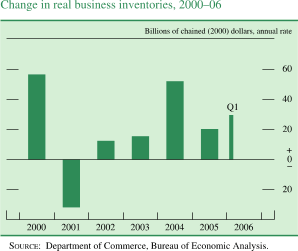
Corporate Profits and Business Finance
Corporate profits were again strong in the first quarter of 2006, and earnings per share for S&P 500 firms rose about 15 percent from the same time last year. Gains were widespread but were especially large for firms in the energy sector. Before-tax profits of nonfinancial corporations measured as a share of sector GDP rose to about 14 percent in the first quarter, above the previous peak reached in 1997.
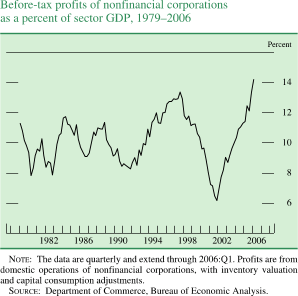
The expansion of business debt picked up to an annual rate of nearly 10 percent in the first quarter of this year, and data in hand suggest a robust pace in the second quarter. A substantial fraction of borrowing proceeds reportedly went to finance mergers and acquisitions in the first half of the year. Net bond issuance has been strong so far in 2006. Short-term borrowing by nonfinancial corporations stepped up in the first quarter of 2006 after slowing somewhat in the fourth quarter of last year; it appears to have remained strong in the second quarter as well. Commercial paper outstanding started rising again, on balance, after edging lower in 2005. Bank business loans outstanding expanded at an annual rate of 15-1/2 percent in the first quarter. Businesses benefited from a more accommodative lending environment: For example, a significant net fraction of respondents to the Federal Reserve's Senior Loan Officer Opinion Survey on Bank Lending Practices in April 2006 noted that their institutions had eased both standards and terms on commercial and industrial loans in the first three months of the year. The most commonly cited reasons for the easing of lending policies were more-aggressive competition from other banks and nonbank lenders, increased liquidity in the secondary market for business loans, and increased tolerance for risk.
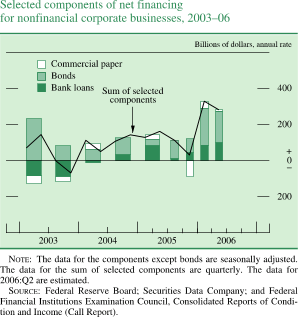
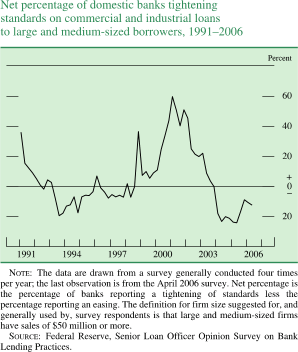
Gross equity issuance has remained moderate so far this year, while an elevated level of cash-financed mergers along with record share repurchases has produced further sizable net equity retirements. Taken together, net funds raised by nonfinancial corporations in the credit and equity markets have been slightly negative in 2006, an indication that nonfinancial corporations have financed their increased investment spending with internal funds.
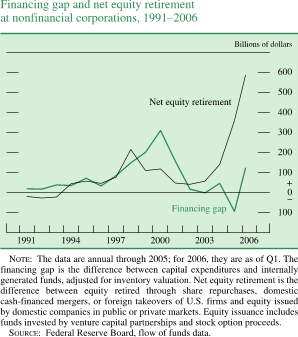
With profitability strong and balance sheets flush with liquid assets, credit quality in the nonfinancial business sector generally has remained quite high. The six-month trailing default rate on corporate bonds dropped after some large firms in the troubled airline and automobile sectors defaulted during the past fall and winter. Delinquency rates on business loans have stayed near the bottom of their historical range.
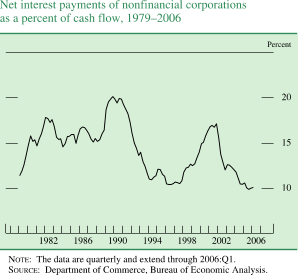

Commercial real estate debt expanded briskly in the first half of 2006, albeit not as quickly as during 2005. Spreads on BBB-rated commercial-mortgage-backed securities have fallen this year. The decline reversed an increase that took place at the end of last year, when issuance surged; these spreads are now back in line with those of comparable-quality corporate bonds. With rents climbing and vacancy rates falling, delinquency rates on commercial real estate loans have been low, and credit quality has remained generally good.
The Government Sector
Federal Government
The deficit in the federal unified budget narrowed further during the past year. Over the twelve months ending in June, the unified budget recorded a deficit of $276 billion, about $60 billion less than during the comparable period last year. The federal deficit over the twelve months ending in June was approximately 2 percent of nominal GDP and was significantly lower than its recent fiscal year peak of 3.6 percent of GDP in 2004. Although outlays increased faster than nominal GDP over the past year, the rise in receipts was even larger. Thus, in its recent Mid-Session Review of the budget, the Administration estimated that the federal government will finish fiscal 2006 with a deficit of $296 billion; that figure marks a decline from the fiscal 2005 deficit of $318 billion and is much lower than most analysts had projected at the beginning of this year.
During the twelve months ending in June, federal receipts were 13-1/4 percent higher than over the same period a year earlier and equivalent to almost 18-1/4 percent of nominal GDP. Income tax receipts from individuals have outpaced the rise in nominal income; final tax payments on income from 2005 were especially strong in April and May. Corporate tax payments continued to rise at a robust rate, even faster than corporate profits.
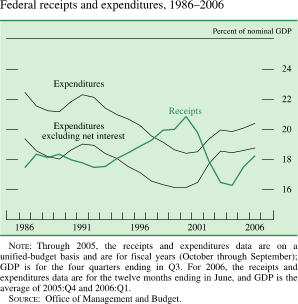
Nominal federal outlays rose 9 percent between June 2005 and June 2006 and were about 20-1/2 percent of nominal GDP. The rise in outlays was bolstered by increases in several components of federal spending. Net interest payments increased 20 percent over the year ending in June as federal debt continued to rise and interest rates increased. Medicare outlays were up 14-1/2 percent; since the inception of the new Part D prescription drug program in January, outlays for benefits have added more than $20 billion to spending in this category. Legislative actions related to the hurricanes in the Gulf Coast region last autumn have added significantly to spending for disaster relief over the past ten months. Although defense spending has slowed from the annual double-digit rates of increase from 2002 to 2004, it still has increased about 8 percent per year in the past two years.
As measured in the national income and product accounts (NIPA), real federal expenditures on consumption and gross investment--the part of federal spending that is a direct component of real GDP--increased at an annual rate of 3-3/4 percent, on average, during the final calendar quarter of 2005 and the first calendar quarter of 2006 and contributed roughly 0.3 percentage point to the annualized change in real GDP over the period. Over these two quarters, real defense purchases were about constant, on average, while spending related to disaster relief from the hurricanes contributed importantly to a rise in real nondefense purchases.
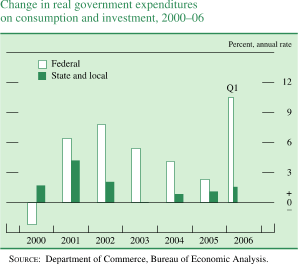
The narrowing of the federal deficit recently has reduced its drain on national saving. However, net national saving excluding the federal government has remained low relative to historical norms. Although the saving rate for private business has moved up during the past two years, the improvement has been offset by the further decline in personal saving. Overall, national saving, net of depreciation, stood at 2-1/2 percent of nominal GDP in the first quarter of 2006. Although the recent rate is a noticeable improvement from the lows of the preceding few years, it has been insufficient to avoid an increasing reliance on borrowing from abroad to finance the nation's capital spending.
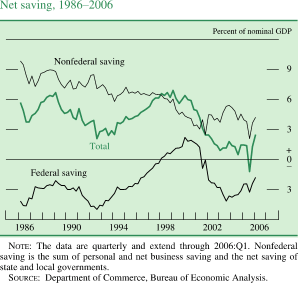
Federal Borrowing
Federal debt rose at an annual rate of 13 percent in the first quarter, a bit less than in the corresponding quarter of 2005. In February, federal debt subject to the statutory limit reached the ceiling of $8.184 trillion, and the Treasury resorted to accounting devices to avoid breaching the limit. The Congress subsequently increased the debt ceiling to $8.965 trillion in March. In the second quarter, federal debt likely declined temporarily because of a surge in tax receipts. On net, the Treasury has raised substantially less cash in the market so far this year than in the comparable period of 2005.
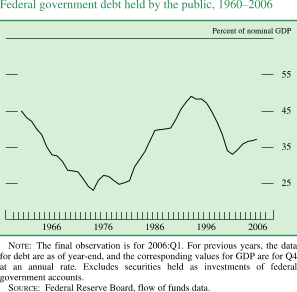
In February, the Treasury conducted an auction of thirty- year bonds for the first time since 2001. The issue generated strong interest, especially from investment funds; foreign investors were awarded only a small fraction of the total. In general, foreign demand for Treasury securities appears to have eased somewhat in 2006. The proportion of nominal coupon securities bought at auction by foreign investors has continued to fall from its peak of 24 percent in 2004; it averaged about 14 percent in the first six months of 2006. Data from the Treasury International Capital system generally suggested subdued demand from both foreign private investors and foreign official institutions over this period. The amount of Treasury securities held in custody at the Federal Reserve Bank of New York on behalf of foreign official and international accounts has changed little since the end of 2005.
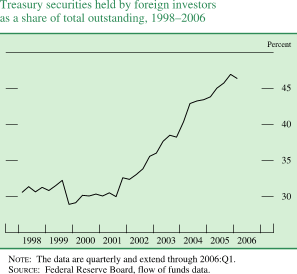
State and Local Governments
The fiscal positions of states and localities continued to improve through early 2006. In particular, revenues are on track to post a relatively strong gain for a third consecutive year. Tax receipts from sales, property, and personal and corporate income were up 8-1/4 percent during the year ending in the first quarter of 2006, a rate similar to the increase in the preceding year. The sustained strength in revenues has enabled these jurisdictions to increase their nominal spending somewhat while rebuilding their reserve funds. On a NIPA basis, net saving by state and local governments--a measure that is broadly similar to the surplus in an operating budget--rose to an annual rate of $21-1/2 billion in the first quarter of 2006 after having been close to zero in 2005. Although most states have seen improvement, a number of states are still struggling with structural imbalances in their budgets, and those in the Gulf Coast region are coping with demands related to damage from last year's hurricanes. In addition, local governments may face pressure to hold the line on property taxes after the sharp increases in the past several years, and governments at all levels will have to contend with the need to provide pensions and health benefits to a rising number of retirees in coming years.
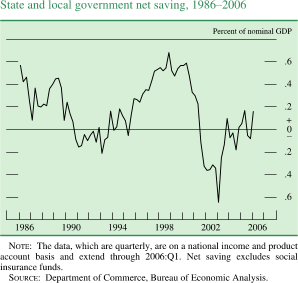
Real expenditures by state and local governments on consumption and gross investment, as estimated in the NIPA, rose at an annual rate of 1-1/2 percent in the first quarter of 2006 after having increased roughly 1 percent per year in 2004 and 2005. Real expenditures for investment turned up in the first quarter after having fallen during the second half of 2005. Real outlays for current consumption posted a moderate increase in the first quarter, and that trend appears to have continued into midyear. Hiring by state and local governments was slow early in the year but appears to have firmed in the spring. Of the cumulative increase in employment of 100,000 between December and June, 40 percent of the jobs were in education.
State and Local Government Borrowing
Borrowing by state and local governments has slowed thus far in 2006. The deceleration likely reflects the general improvement in budget conditions and a decline in advance refundings, which have dropped below their 2005 pace amid rising interest rates and a dwindling pool of eligible securities. Credit quality in the state and local sector has continued to improve, and upgrades of credit ratings have far outnumbered downgrades. Consistent with the improvement in credit quality, yields on long-dated municipal bonds have increased substantially less than those on comparable- maturity Treasury securities, and the yield ratio has accordingly fallen sharply.
The External Sector
The U.S current account deficit narrowed in the first quarter of 2006 to $835 billion at an annual rate, or about 6-1/2 percent of nominal GDP, from $892 billion in the fourth quarter of 2005. The narrowing resulted from three factors. Unilateral transfer payments to foreigners dropped, largely because of a decrease in government grants. The trade deficit narrowed, primarily because the value of imported oil and natural gas declined. In addition, higher direct investment receipts and lower direct investment payments produced an increase in the investment income balance.
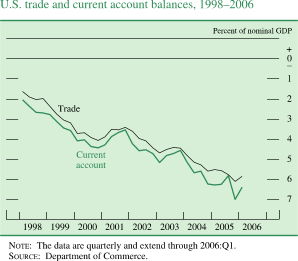
International Trade
Real exports of goods and services increased 14-3/4 percent at an annual rate in the first quarter of 2006, far faster than the 6-1/2 percent rate recorded in 2005. The surge in export growth in the first quarter resulted in part from a recovery in exports of many types of industrial supplies following a period of hurricane-related disruptions late last year. Exports of capital goods also increased rapidly in the first quarter, with deliveries of aircraft to foreign carriers exhibiting particular strength. The first-quarter increase in exports was widespread across destinations, a sign of robust economic activity in many parts of the world, and exports to Mexico and Canada showed especially large increases. Real exports of services rose at an annual rate of about 6-1/2 percent in the first quarter after increasing just 2-3/4 percent in 2005. Available data for nominal exports in April and May suggest that the increase in real exports was smaller in the second quarter, held down in part by a drop in aircraft exports after a strong first quarter.
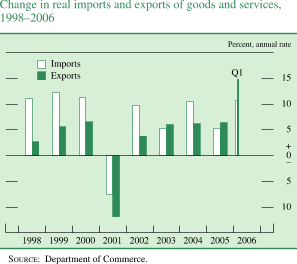
Prices of exported goods increased at an annual rate of 2-3/4 percent in the first quarter of 2006, a pace somewhat faster than in the second half of 2005. Prices of non-agricultural industrial supplies continued to increase steadily in the first quarter, driven importantly by higher prices for oil and metals. An acceleration in prices for finished goods, especially for capital and consumer goods, contributed to the faster pace of export price inflation in the first quarter. The available data for the second quarter point to further increases in export prices on the strength of additional run-ups in the prices of non-agricultural industrial supplies, especially metals.
Real imports of goods and services rose at an annual rate of 10-3/4 percent in the first quarter, slightly slower than in the fourth quarter but still considerably faster than the 5-1/4 percent rate observed for 2005 as a whole. Robust growth of real GDP in the United States supported the first-quarter increase in imports. Among categories of goods, large increases in imports of consumer goods, automotive products, and capital goods, particularly computers, more than offset declines in imports of oil and some other industrial supplies. The rise in imports in the first quarter was widely distributed across countries, and the increases for China and Mexico were especially large. Real imports of services jumped at an annual rate of 8-1/2 percent in the first quarter. Nominal imports in April and May point to an abrupt slowing of real imports in the second quarter from the first quarter's rapid pace.
Prices of imported goods excluding oil and natural gas rose at an annual rate of about 1 percent in the first quarter of 2006, -3/4 percentage point faster than the pace in the second half of 2005. Prices of material-intensive goods, such as nonfuel industrial supplies and foods, increased steadily in the last quarter of 2005 and in the first quarter of 2006. Also in the first quarter, prices of finished goods, such as consumer goods and many kinds of capital goods, turned up slightly. Available data for the second quarter indicate that prices of finished goods kept rising at a subdued pace. However, prices of material-intensive goods continued to increase sharply, a development reflecting higher prices for metals. The International Monetary Fund's index of global metals prices rose 46 percent between December 2005 and May 2006, largely because of robust global demand. In June, metals prices retreated about 8 percent, although they remained well above the levels of earlier this year.
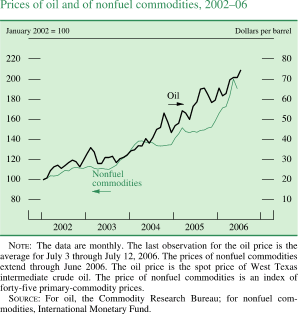
The spot price of West Texas intermediate crude oil increased from around $60 per barrel at the end of last year to more than $75 per barrel in July, higher than the peak that followed last year's hurricanes. Oil prices have been highly sensitive to news about both supply and demand, particularly in light of the narrow margin of worldwide spare production capacity. Global oil demand has continued to grow as the foreign economic expansion has spread, and developing countries have posted the largest increases in oil consumption. Recent events in the Middle East--including concerns over Iran's nuclear program, violence in Iraq, and the recent conflict in Lebanon--have put additional upward pressure on oil prices. In Nigeria, attacks against oil infrastructure have reduced oil production for most of this year. Government intervention in energy markets also raised concerns about supply from some countries: In recent months, Bolivia nationalized its natural gas reserves, and Venezuela and Russia continued to tighten governmental control of their energy industries.
The rise in the price of the far-dated NYMEX oil futures contract (currently for delivery in 2012) to more than $70 per barrel likely reflects a belief by oil market participants that the balance of supply and demand will remain tight over the next several years.
The Financial Account
The U.S. current account deficit continues to be financed primarily by foreign purchases of U.S. debt securities. Foreign official inflows in the first quarter maintained the strength exhibited in 2005 but remained below the record levels of 2004. As in recent years, the majority of these official inflows were attributable to Asian central banks and have taken the form of purchases of U.S. government securities.
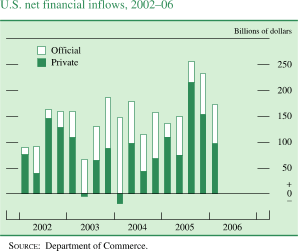
Foreign private purchases of U.S. securities continued in the first quarter at the extraordinary pace set in the second half of 2005. Although private flows into U.S. Treasury bonds were significantly smaller than in recent quarters, this slowing was more than offset by larger flows into agency bonds and equities. Preliminary data for April and May suggest a slowdown in foreign purchases of U.S. securities relative to the first quarter. Foreign direct investment flows into the United States continued in the first quarter near last year's average levels.
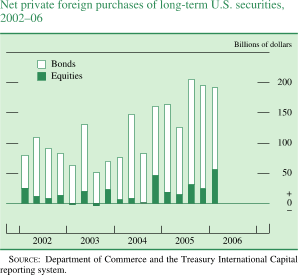
Net purchases of foreign securities by U.S. residents, which represent a financial outflow, strengthened slightly in the first quarter and continued at a solid pace in April and May. In addition, significant outflows were associated with U.S. direct investment abroad, a reversal of some unusual inflows in the second half of 2005. These second- half inflows were prompted by the partial tax holiday offered under the 2004 Homeland Investment Act (HIA), which induced the foreign affiliates of U.S. firms to repatriate a portion of earlier earnings that had been retained abroad. In the first quarter, the foreign affiliates partially unwound the HIA-induced flows by retaining an unusually large portion of their first-quarter earnings. Increased merger activity abroad also boosted direct investment outflows in the first quarter.
The Labor Market
Employment and Unemployment
Conditions in the labor market continued to improve in the first half of 2006, although the pace of hiring has slowed in recent months. Nonfarm payroll employment increased 176,000 per month during the first quarter, a rate roughly in line with the relatively brisk pace that prevailed during 2004 and 2005. During the second quarter, hiring slowed, and monthly gains in payrolls averaged 108,000 jobs per month. Over the two quarters, the civilian unemployment rate edged down further, to the lowest quarterly level of joblessness in five years.
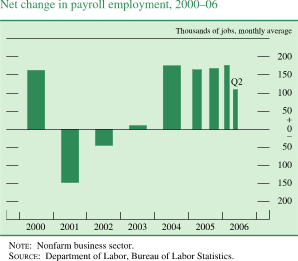
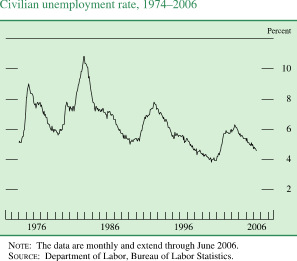
In the first quarter, with homebuilding quite strong, hiring continued to be particularly robust at construction sites; part of this strength was the result of favorable weather, which allowed more construction activity than is typical during the winter months. Although nonresidential construction activity was firming by the spring, the pullback in housing starts slowed the demand for residential contractors and workers in the building trades. As a result, monthly additions to construction industry payrolls declined from more than 25,000 per month in the first quarter to just 3,000 per month in the second quarter. Cutbacks at retailers also were an important factor holding down the overall gain in employment in the second quarter. After having been stable early in 2006, employment at retail outlets fell almost 30,000 per month between March and June; most of the cutbacks occurred at general merchandisers.
In other sectors, employment remained on a solid upward trend during the first half of the year. As has been the case since mid-2004, establishments providing education and health services, those offering professional and technical business services, and those involved in financial activities, taken together, added more than 60,000 jobs per month. Employment in manufacturing, which had turned up at the end of 2005, rose further over the first half of 2006. Expanding industrial production was also associated with further job gains in related industries, such as wholesale trade and transportation. In addition, the increase in energy production led to a sustained rise in employment in the natural resources and mining industry over the first half of the year.
The increase in job opportunities so far in 2006 led to a further reduction in the civilian unemployment rate, from an average of 5.0 percent in the second half of 2005 to 4.7 percent in the second quarter of 2006. Although hiring moderated in the spring, layoffs remained low. New claims for unemployment insurance (UI) dipped below 300,000 per week in January and February and then fluctuated around a still-low level of about 315,000 per week for most of the period from March through early July. Over the first half of 2006, longer-term unemployment (fifteen weeks or more) also moved down, and the proportion of UI claimants who remained on the unemployment rolls until the exhaustion of their benefits continued to recede.
After having edged up during 2005, the labor force participation rate was relatively stable over the first half of 2006 despite the ongoing improvement in labor market conditions. Rates for most broad age groups were little changed from last year's levels. From a longer perspective, developments during the past decade highlight the importance of structural as well as cyclical influences on participation. The rise in the attachment of adult women to the workforce, which was a significant factor in the secular rise in participation over much of the post-World War II period, appears to have leveled off. And the aging of the population is increasing the proportion of the workforce that is 55 years and older; it rose from less than 12 percent in 1996 to 16-3/4 percent in recent months. Although older workers have tended in recent years to stay in the labor force longer, their participation rate, at 38 percent in the second quarter, was less than half the rate for workers who are age 25 to 54. Thus, the demographic shift to an older population has already begun to reduce the overall rate of labor force participation and has offset part of the rise in participation that has been associated with the cyclical upturn in job creation. The secular forces that are slowing the expansion of the labor force imply that the increase in employment that is consistent with a stable unemployment rate will, over time, be smaller than it was during the period when labor force participation was rising steadily.
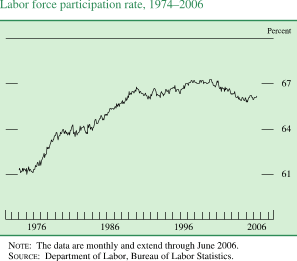
Productivity and Labor Costs
After having advanced at an unusually rapid rate from 2001 to mid-2004, labor productivity in the nonfarm business sector increased at a more moderate annual rate of 2-1/2 percent from mid-2004 to early 2006. Nonetheless, by historical standards, productivity performance recently has still been solid, with gains at a rate matching those during the second half of the 1990s. In an environment of a sustained expansion of aggregate demand, businesses have gradually adjusted their use of labor, capital, and services to achieve ongoing gains in efficiency. Productivity has continued to benefit importantly from investment in new technologies, organizational changes, and improvements in business processes, although the contribution from capital deepening has been smaller in recent years than it was during the capital investment boom of the late 1990s.
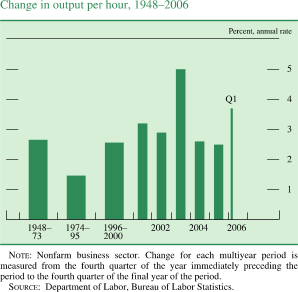
Broad measures of hourly labor compensation, which include both wages and the costs of benefits, posted moderate gains over the year ending in early 2006 despite the run-up in headline price inflation and the further tightening of labor markets. Both the employment cost index (ECI) and the estimate of compensation per hour that uses data from the national income and product accounts increased 2-3/4 percent between the first quarter of 2005 and the first quarter of 2006.1 Both series had reported higher rates of change in hourly labor compensation a year earlier.
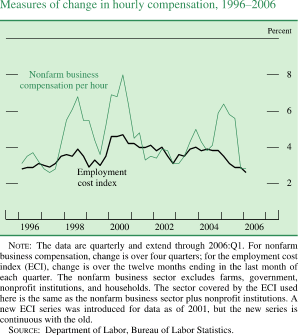
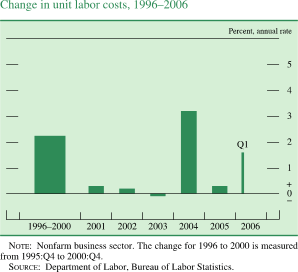
The deceleration in labor compensation appears to have been associated largely with smaller increases in employers' benefit costs. The benefits component of the ECI was up just 3 percent between March 2005 and March 2006, compared with an increase of 5.5 percent between March 2004 and March 2005. The cost of health insurance, which typically accounts for about one-fourth of overall benefit costs, rose just 4-3/4 percent during the year ending in March 2006; between 2000 and 2005, these costs increased, on average, 8-3/4 percent per year. Another likely contributor to the slower rise in benefit costs over the past year was smaller employer contributions to their defined-benefit pension plans; those costs dropped back somewhat after employers made sizable payments to bolster those pension assets in 2004.
Indicators of the recent trend in the wage component of worker compensation have been providing mixed signals. As measured in the ECI, wages rose 2.4 percent between March 2005 and March 2006, slightly less than in the preceding two years. In contrast, the year-over-year change in average hourly earnings of production or nonsupervisory workers--which refers to a narrower group of private nonfarm employees and has tended to show greater cyclical variation than the ECI--has increased steadily over the past three years. Average hourly earnings rose 3.9 percent over the twelve months ending in June 2006, compared with an increase of 2.7 percent over the twelve months ending in June 2005.
Prices
Inflation pressures were elevated during the first half of 2006. The chain-type price index for personal consumption expenditures (PCE) rose at an annual rate of 4-1/4 percent between December 2005 and May 2006. Over the same period, core PCE prices increased at an annual rate of 2.6 percent, nearly 0.6 percentage point faster than over the twelve months of 2005.
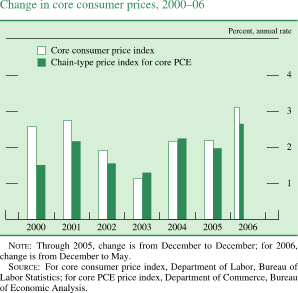
Although energy prices eased temporarily in February, they turned up sharply again from March to May; as a result, the PCE price index for energy increased 13 percent (not at an annual rate) over the first five months of 2006, a rise that marked a continuation of the steep climb in prices that began in 2004. This year, almost the entire rise in energy prices has been associated with higher prices for petroleum- based products. The PCE price index for gasoline and motor fuel, which increased more than 16-1/2 percent last year, climbed another 24 percent (not at an annual rate) by May. Although recent data from the Department of Energy indicate that gasoline prices fell back in June, they moved up again in early July. Retail prices of gasoline this year have risen faster than the cost of crude oil in part because of the additional cost of producing and distributing reformulated product with ethanol. Also, the demand for fuel ethanol has been strong relative to the current capacity to produce it. In contrast, the consumer price of natural gas has turned down this year as inventories have remained relatively high; the price decline between January and May almost completely reversed the steep run-up that occurred last autumn.
Food price inflation remained moderate during the first five months of 2006; between December 2005 and May 2006, the PCE price index for food and beverages increased at an annual rate of 2-1/4 percent. Retail prices of meat and poultry have fallen so far this year. Domestic supplies of meat have been ample. Production has been expanding at a time when export demand for beef has been soft largely because of bans on imports of U.S. beef by Japan and Korea. Prices of processed food have continued to rise at only a moderate rate despite higher prices for grains; export demand for grains has been strong, and the price of corn has been boosted by demand from producers of ethanol. Prices for food consumed away from home, which typically are influenced heavily by labor and other business costs, have continued to increase relatively rapidly, rising at an annual rate of 3-3/4 percent over the first five months of the year.
The pickup in core inflation in the first half of 2006 was evident in the indexes for both goods and services. Prices of consumer goods excluding food and energy, which were unchanged in 2005, edged up at an annual rate of 3/4 percent this year. Prices of consumer services also accelerated this spring; as a result, the PCE price index for non-energy services increased at an annual rate of 3-1/2 percent between December 2005 and May 2006, compared with a rise of 2-3/4 percent in 2005. In the three months ending in May, increases in housing rents were especially steep; the rise may reflect, in part, a shift in demand toward rental units because home purchases have become less affordable. Another contributor to the higher inflation rate for consumer services has been the acceleration in the index for nonmarket services to an annual rate of 4 percent over the first five months of the year from 3 percent last year.2 More broadly, the pickup in core consumer price inflation over the first five months of 2006 likely is the result of the pass-through of higher energy costs to a wide range of goods and services.
The cost pressures from the increase in energy costs during the past three years have been apparent in rising prices of inputs used in the production and sale of final goods and services. The producer price index for intermediate goods, excluding food and energy, rose at an annual rate of 7-1/4 percent between December 2005 and May 2006; this index rose 4-3/4 percent in 2005 and 8-1/4 percent in 2004. In particular, prices of industrial chemicals, fertilizer, and stone and clay products, for which energy represents a relatively high share of the total costs of production, accelerated over the past several years. The costs of a number of important business services, particularly transportation by air, rail, and truck, have also been boosted by higher energy costs. The pass-through of the costs of energy to consumer prices is clear for a few items, such as airfares. For other components of core consumer price indexes, however, the extent of the pass-through is harder to trace. Quantifying the extent of the pass-through is difficult, in part because it is diffused through a wide range of retail goods and services. In addition, the cost of energy is a small share of overall costs--and that share has been declining over time as businesses adopt more energy-efficient technologies and households reduce their consumption of energy. Nonetheless, the cumulative rise in energy costs in recent years has been large enough to show through to pricing of final goods and services even as businesses have seen their labor costs, which represent roughly two-thirds of their costs, remain restrained.
